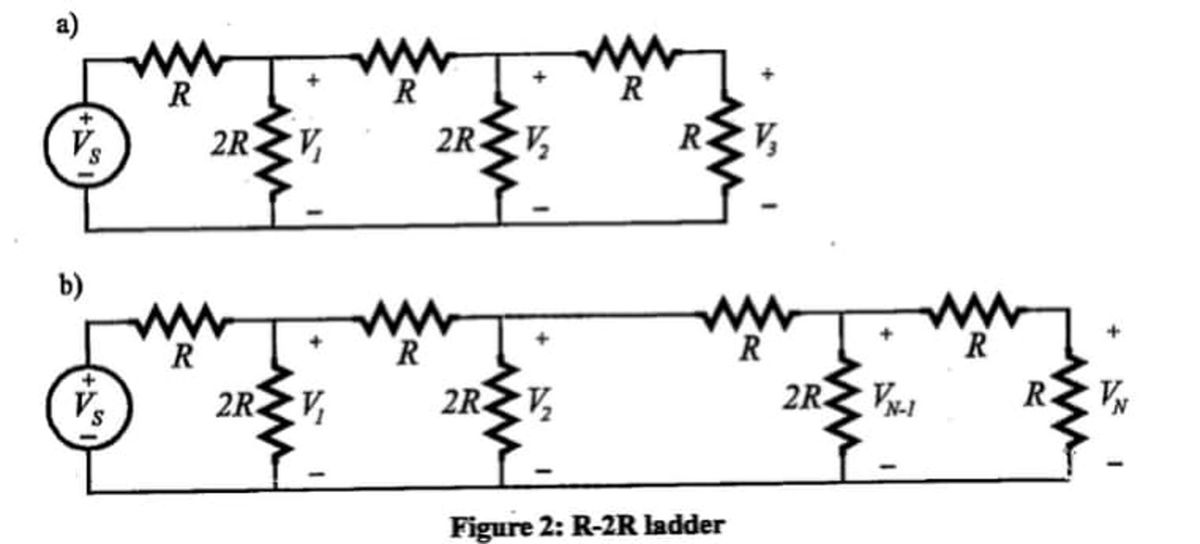a) Vs b) + Vs R R V-423, V, -1/3 Vs = = 4 V=1/4 V₂ 2R. 2R + + V₂ and V₁ = R 8 2R. V/₂2 + 2RZV₂ - R + V3 R 2RZ VN-1 Figure 2: R-2R ladder The name R-2R ladder comes from the configuration of resistors. The three resistors that form the horizontal rungs running across the top of the ladder have value R, whereas the vertical resistors have value 2R, except for the last (rightmost) resistor, which has value R. For this case, you can verify that the voltages across the vertical resistors are R R. VN (3) For the more general case of Figure 2b, which has N vertical resistors, you can verify that that the voltage across the kth resistor is
a) Vs b) + Vs R R V-423, V, -1/3 Vs = = 4 V=1/4 V₂ 2R. 2R + + V₂ and V₁ = R 8 2R. V/₂2 + 2RZV₂ - R + V3 R 2RZ VN-1 Figure 2: R-2R ladder The name R-2R ladder comes from the configuration of resistors. The three resistors that form the horizontal rungs running across the top of the ladder have value R, whereas the vertical resistors have value 2R, except for the last (rightmost) resistor, which has value R. For this case, you can verify that the voltages across the vertical resistors are R R. VN (3) For the more general case of Figure 2b, which has N vertical resistors, you can verify that that the voltage across the kth resistor is
Introductory Circuit Analysis (13th Edition)
13th Edition
ISBN:9780133923605
Author:Robert L. Boylestad
Publisher:Robert L. Boylestad
Chapter1: Introduction
Section: Chapter Questions
Problem 1P: Visit your local library (at school or home) and describe the extent to which it provides literature...
Related questions
Question
Derive the equations below by using the circuits:

Transcribed Image Text:a)
V
b)
V₂
Vs
M
R
R
2R
2*
+
V₂
2R V₁
V₂
Vs, V3
V₁ = 1/2, V₂ = 4 and V₂ =
R
Vs
8
R
2R.
2R
V₂
V/₁₂
R
+
V₂
R
2RZ VN-1
Figure 2: R-2R ladder
The name R-2R ladder comes from the configuration of resistors. The three resistors that form the horizontal rungs
running across the top of the ladder have value R, whereas the vertical resistors have value 2R, except for the last
(rightmost) resistor, which has value R. For this case, you can verify that the voltages across the vertical resistors are
R
+
VN
For the more general case of Figure 2b, which has N vertical resistors, you can verify that that the voltage across the th
resistor is
(3)
Expert Solution
Step 1: Stating the given data
Given circuit:

Asked to derive the voltages of ,
and
.
Step by step
Solved in 4 steps with 6 images

Knowledge Booster
Learn more about
Need a deep-dive on the concept behind this application? Look no further. Learn more about this topic, electrical-engineering and related others by exploring similar questions and additional content below.Recommended textbooks for you

Introductory Circuit Analysis (13th Edition)
Electrical Engineering
ISBN:
9780133923605
Author:
Robert L. Boylestad
Publisher:
PEARSON

Delmar's Standard Textbook Of Electricity
Electrical Engineering
ISBN:
9781337900348
Author:
Stephen L. Herman
Publisher:
Cengage Learning

Programmable Logic Controllers
Electrical Engineering
ISBN:
9780073373843
Author:
Frank D. Petruzella
Publisher:
McGraw-Hill Education

Introductory Circuit Analysis (13th Edition)
Electrical Engineering
ISBN:
9780133923605
Author:
Robert L. Boylestad
Publisher:
PEARSON

Delmar's Standard Textbook Of Electricity
Electrical Engineering
ISBN:
9781337900348
Author:
Stephen L. Herman
Publisher:
Cengage Learning

Programmable Logic Controllers
Electrical Engineering
ISBN:
9780073373843
Author:
Frank D. Petruzella
Publisher:
McGraw-Hill Education

Fundamentals of Electric Circuits
Electrical Engineering
ISBN:
9780078028229
Author:
Charles K Alexander, Matthew Sadiku
Publisher:
McGraw-Hill Education

Electric Circuits. (11th Edition)
Electrical Engineering
ISBN:
9780134746968
Author:
James W. Nilsson, Susan Riedel
Publisher:
PEARSON

Engineering Electromagnetics
Electrical Engineering
ISBN:
9780078028151
Author:
Hayt, William H. (william Hart), Jr, BUCK, John A.
Publisher:
Mcgraw-hill Education,